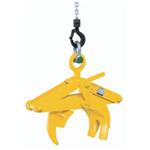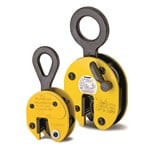Below the Hook
TIGRIP® load handling attachments have been a byword for reliability, quality and safety for over 35 years. For transport by hoist, we offer the optimum load handling attachment for almost every application. Our range includes grabs, lifting clamps, tension clamps, transport eyes, C-hooks, spring balancers, lifting magnets, load handling equipment for civil engineering, lifting beams, crane forks and weighing equipment. We are of course always available for further advice.

Of course, you will receive a CE declaration of conformity for each product in accordance with the Machinery Directive 2006/42/EC and operating instructions in the respective national language. TIGRIP® products guarantee the highest level of product safety and comply with all applicable standards.
Featured brands
With a family of trusted global brands, Columbus McKinnon products leverage our company's rich history in industrial manufacturing to revolutionize the future of lifting and motion control.
Tigrip load receptors - for efficient and safe material transport!
With us you will find the right load handling device, sling and lifting device for your application.
Grippers - Lifting grippers & lifting pliers
Grippers for turning, lifting and transporting loads. (pipe grippers, block grippers, drum grippers, drum pliers).
Lifting clamps & sheet metal grippers
Clamps for vertical and horizontal transport of sheets and profiles.
(sheet metal grippers, sheet metal clamps, general purpose grippers, soft grippers, screw clamps)
Permanent lifting magnets
Permanent lifting magnets for lifting magnetic loads are particularly durable and low-maintenance.
Trusses - Load beams & crane beams
Trusses for long, bulky and heavy loads. (H-trusses, forklift trusses)
Crane forks and loading forks
Krangabel or loading fork for palletized goods with manual or automatic weight balancing.
Coil hook - C-hook
C-shaped hooks ideal for the safe transport of annular loads such as coils.
Spring balancers and balancers
Balancers are used to relieve the operator of the weight of the tool.
Weighing technology & crane scales
Crane scales to detect weights or measure forces.
Textile slings
Textile slings with high load-bearing capacity and low dead weight. , slings
Lifting equipment - Lifting equipment
Wide range of hoists in the load capacity ranges from 250 – 50,000kg.
Featured Products
Questions on determining the appropriate load handling device:
Clamps and grippers:
What is being transported - information on the load:
- Weight
- Length
- Width
- Height
- External diameter
- Inside diameter
- Material: e.g. steel, concrete, wood, paper...
- Surface hardness of steel
- Surface finish: oiled, greasy, dry, scale,...
- How should or may the load be gripped/clamped: Underlay - Toothing - protective covering,...
- Dimensions or crane hook type
Application instructions for load handling equipment:
- Only undamaged lifting accessories with a legible load capacity and type plate and gripping range information may be used.
- Visual inspection of the load handling device for obvious defects before the first and each subsequent use!
- The support ring must have sufficient space in the load hook and be freely movable. There must be a safety device against unintentional unhooking of the load handling device from the hook. A short intermediate hanger between the crane hook and the load handling device makes it easier to strike and increases safety!
- Staying under a lifted load is strictly prohibited. Attention: A secure, form-fitting connection also requires sufficient strength of the lifting material. It must be ensured that the load or parts of it cannot slip and fall!
- The lifting accessory shall be positioned above the centre of gravity of the load in such a way that no pendulum movement occurs when the load is lifted.
- If longer sheets or profiles are to be transported, it is recommended to use two clamps to avoid pendulum movements. These can be used either in conjunction with a crossbeam or, for example, with a two-strand sling device and clamps with a swivel eye (e.g. TBS model) within the permissible angle of inclination (observe load capacity reductions).
- Clamps without a swivel eyelet must not be loaded laterally! (Placing the clamp on the sheet metal at an angle in the tensile direction of the sling is usually not permitted, as the clamping jaws then grip too close to the edge of the sheet. A correct fit of the clamp on the hoist is not given in this way!)
- The clamps must be placed on the sheet metal to be transported as far as they will go, and the housing must rest on both sides of the edge of the sheet metal.
- With clamps for transporting sheet metal in a vertical position, only a single sheet of metal may be transported at a time. The clamping effect must be given at the front and back of a hoist!
- For the transport of sheets in a horizontal position, depending on the design, e.g. in the case of sheet metal packages that do not bend, several sheets can also be lifted together with appropriate clamp types or lifting harnesses.
- Do not leave loads in a lifted or tensioned state for long periods of time or unattended.
- When attaching, care must be taken to ensure that the load handling device can be operated in such a way that the slinger is not endangered by the device itself, nor by the lifting device, or the load.
- The operator may not initiate a load movement until he is satisfied that the load is correctly attached and that there are no persons within the danger zone.
- Please note the reduced load capacities for clamps depending on the swivel range of the support ring or the direction of use of the clamp. (Attention - not all terminal types on the market are suitable for a swivel range of 180° - follow the operating instructions carefully!)
- In the event of malfunctions, the lifting accessory must be taken out of service immediately.
INFO: A large number of other use cases have not been discussed here, please contact us, we will be happy to advise you!
FAQ – Frequently Asked Questions
What is meant by load handling equipment?
Lifting accessories belong to the load handling devices. They are an interchangeable link between the hoist and the load and are often combined with slings. The Machinery Directive 2006/42/EC and the DIN EN 13155 standard apply to lifting accessories.
Load handling devices can be used to grip, clamp, attach or magnetically attach loads. There are different types of load handling devices, these include, for example: load beams, lifting clamps (pliers), coil hooks, lifting grippers, loading forks.
They all share the common goal of making it easier and safer to move heavy objects.
Definition of load handling equipment according to Machinery Directive 2006/42/EC:
'A component or piece of equipment, other than that of the hoist, which enables the load to be gripped and which is placed between the machinery and the load or on the load itself, or which is intended to become an integral part of the load and which is placed on the market separately; lifting accessories shall also include slings and their components."
What are slings?
Slings are also a lifting device and serve as a detachable link between the hoist and the load or hoist and the lifting device.
Slings include, for example, round slings, lifting straps, sling ropes or sling chain chains, shackles and anchor points.
What needs to be considered when using load handling devices?
- Load: The load capacity (WLL) indicated on the device is the maximum load that must not be exceeded.
- Temperature: Clamps without protective coating can usually be used (depending on the manufacturer) from -40 °C to +100 °C with the full load capacity. Due to the use of glued-on coverings, clamps with protective coatings may usually only be used for lower temperature ranges - e.g. model TBP, model TSB from - 20 °C to + 40 °C.
- Shock load, oscillating load: The specified load capacities require a shock-free load on load handling equipment. Slight impacts, e.g. by lifting and lowering or moving the load on the crane, are permitted. Strong shocks (e.g. bumping into the load during transport) or oscillation of the load are not permitted!
- Chemicals: Load handling devices must not be used without hesitation in the area of chemicals or in the environment of chemical vapors - let us advise you beforehand! Load handling equipment that has been exposed to chemicals or their fumes must be taken out of service and handed over to us for assessment.
- Passenger transport: In principle, the transport of persons with load handling devices is prohibited!
- Use under hazardous conditions: Lifting or transporting loads must be avoided as long as persons are in the danger zone of the load. In the case of terminals that do not work in terms of form but force or friction without additional protection, the load must not be carried over persons under any circumstances - see BetrSichV!
- Lifting equipment: Load handling devices are designed for special applications and lifting goods by the manufacturer and may not be used for other applications without consultation. e.g. the thickness of the material (gripping area of the clamp), surface finish, surface hardness* of the material and the temperature of the material must be taken into account. The information on this can be found in the respective operating instructions. These must be made available to users for safe use. *Please note that the surface and core hardness of special sheets can vary considerably: e.g. cold work tool steel
What needs to be checked before starting work?
- Care must be taken to ensure that the surfaces of the sheet where the clamp is attached are as dry as possible, free of grease, paint, dirt, scale and coating, so that the contact of the teeth with the lifting material is not hindered or protective coatings can generate the required friction.
- Fixed and clamping jaws or their protective linings must be checked for wear and defects. Both jaws must have a clean profile and the teeth must not be too worn. (Observe the information in the operating instructions, approx. guideline max. 30% wear). Protective coverings must not be dirty, damaged, uneven or worn too much.
- The entire lifting accessory must be checked for damage, corrosion, cracks or deformations.
- The clamp must be easy to open and close.
- Feather check. In the "closed" position, this must have a clearly noticeable spring force when you press on the suspension eye.
Who is allowed to test load handling equipment?
Repairs and inspections may only be carried out by qualified persons or inspectors who use original spare parts. Continuous records must be kept of this.
Load handling devices must be maintained at the prescribed intervals for safe operation in accordance with the manufacturer's maintenance instructions.
For mandatory maintenance (usually at least once a year, depending on the frequency of use and severity), or if defects are found, you can send your load handling equipment to us for assessment and repair.

 Middle East - EN
Middle East - EN















